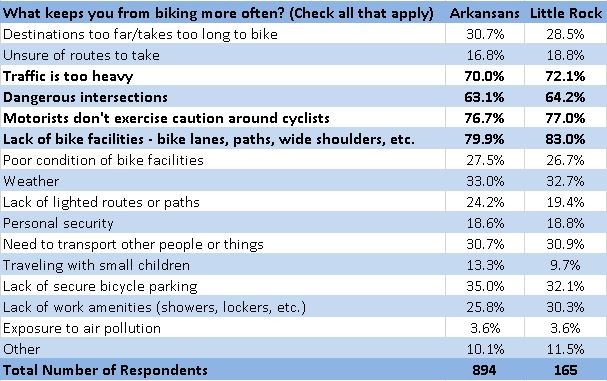Goals
The following page was written in response to a question within the League of American Bicyclists Bicycle Friendly Community application:
G4. What could be done differently in order to make bicycling safer, more enjoyable and/or more convenient in your community?
Answering the question in this format allows weblinks and graphics with more information to be presented without distracting from the response's narrative. If you have feedback about what is written below or have additional feedback, please consider reaching out to the City of Little Rock's Bicycle Friendly Community Committee by attending a monthly meeting or emailing the BFCC Chair. The BFCC is tasked with advising the City about how to become more bicycle-friendly. Please also reach out to the City of Little Rock Bicycle and Pedestrian Coordinator.
Bicycle Friendly Community Committee 2019 Transportation Goals
The following is a summary of the Bike Friendly Community 2019 Goals.
Promote Smart Growth: In order for the bicycle to be an effective transportation mode, origins and destinations must be close together. Residents struggle to use bicycles for transportation when our built environment is planned around Euclidean zoning and its resulting urban sprawl. While these challenges are hardly unique to Little Rock, our high vehicle miles traveled per day relative to comparable communities (pg. 5) illustrates how impactful promoting smart growth to welcome to bicycle transportation can be in our community (Goal 1).
Complete and Expand Our Off-Street Trail Network: As mentioned in G2, construction of the Arkansas River Trail may be our community’s most important bicycling outcome to date. However, work remains to make this a transportation and recreation resource for all ages and abilities. The most dangerous portion of the trail is the section in front of Dillard’s headquarters; right-of-way conflicts have prevented the City from addressing this section. While the City has addressed several ART problems since 2016 (G3), several problems remain (Goal 2.10). Since 2016, trails expanding from the ART have come closer to realization. The 63-mile Southwest Trail will not only be a nationally-important recreational trail from Little Rock to Hot Springs, but it will also be an important north-south corridor within Little Rock and address equity issues caused by the construction of I-630 (Goal 2.11). The Southeast Trail will link east Little Rock neighborhoods, the airport, and communities east of Little Rock to our urban core by bicycle (Goal 2.14). Together, and with other projects discussed in Goal 2, these trails will create a core trail network hub that will be useful for transportation and recreation.
Complete a Low-Stress, Dense, On-Street Bicycle Network: When asked “What keeps you from biking more often?” the four most common answers from Little Rock residents, by far, have to do with the fear of being struck by a motor vehicle (Table 1). The top answer is a lack of bike facilities. Evidence from other communities continues to show that quality, connected networks effectively linking origins to destinations encourage ridership. In order to make the financial cost of our bike network negligible, we have elected to primarily install on-street facilities only in the context of reconstructing or resurfacing streets. For these piecemeal facilities to encourage ridership, we need to consider connections between these facilities that would have the highest yield (i.e. constructing a network). The type of on-street facilities must also match current best practices (FHWA Bikeway Selection Guide). Thankfully, we are in the process of contracting with outside consultants with national bicycle network planning expertise; their process and product should help us move toward this goal (Goal 2.1).

Table 1. The Arkansas Bicycle and Pedestrian Transportation Plan gave us valuable insights into the relative efficacy of different interventions to encourage bicycling.




 Trash & Recycling
Trash & Recycling
 Online Payments
Online Payments
 City Documents
City Documents
 Parks
Parks
 Traffic Court
Traffic Court
 E-NEWS
E-NEWS
 EXPLORE
EXPLORE
 NEWS
NEWS
 TRANSLATE
TRANSLATE
